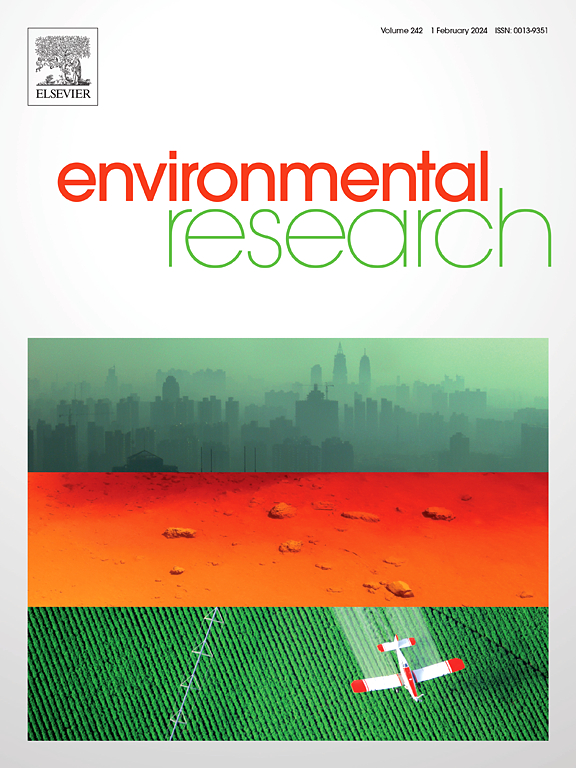Associations between prenatal exposure to a mixture of lead, mercury and polychlorinated biphenyls and executive function in Inuit adolescents
IF 7.7
2区 环境科学与生态学
Q1 ENVIRONMENTAL SCIENCES
引用次数: 0
Abstract
Numerous studies have investigated the individual contribution of prenatal exposure to lead (Pb), mercury (Hg) and polychlorinated biphenyls (PCBs) on neurocognitive development, but few have explored their combined influence, particularly on executive function, during adolescence. This study aims to assess the associations between prenatal exposure to Pb, Hg and PCB-153 and executive function in mid-to-late adolescence. Two-hundred twelve Inuit participants (mean age = 18.5 years, range = 16.0 to 21.9) from Nunavik, Canada, completed four tasks assessing executive function: a Stop Task, a 2n-back task, the D-KEFS Trail Making Test and the Tower of London. Exposure to Pb, Hg and PCB-153 was estimated in cord blood samples at birth, and in blood samples at 11 years old and at time of testing. Bayesian Kernel Machine Regression and traditional multiple linear regression models were performed to estimate mixture and individual effects. All models were adjusted for sociodemographic characteristics and fish nutriments as well as for postnatal contaminant exposure in secondary analyses. Mixture modeling of concurrent prenatal exposure to Pb, Hg and PCB-153 did not reveal any statistically significant associations with executive function. However, results from the single-pollutant regression models showed a negative log-linear relationship between cord Pb concentrations and cognitive planning, which remained statistically significant after controlling for postnatal exposure (β = −0.178, 95 % CI = [-0.327, −0.021], p = 0.021). This study suggests that prenatal exposure to Pb is detrimental to executive function in late adolescence. Further research is needed to replicate findings and better understand the functional significance of this long-lasting association and how it might evolve during adulthood.

因纽特青少年产前接触铅、汞和多氯联苯混合物与执行功能之间的关系
许多研究已经调查了产前暴露于铅(Pb)、汞(Hg)和多氯联苯(pcb)对神经认知发育的个体贡献,但很少有研究探索它们在青春期的综合影响,特别是对执行功能的影响。本研究旨在评估产前暴露于铅、汞和多氯联苯-153与青春期中后期执行功能之间的关系。来自加拿大努那维克的212名因纽特人参与者(平均年龄18.5岁,范围16.0至21.9岁)完成了四项评估执行功能的任务:停止任务,2n-back任务,D-KEFS Trail Making Test和伦敦塔。在出生时的脐带血样本,以及11岁时和测试时的血液样本中,估计暴露于铅、汞和多氯联苯-153。采用贝叶斯核机回归和传统的多元线性回归模型来估计混合效应和个体效应。在二次分析中,所有模型都根据社会人口学特征和鱼类营养以及出生后的污染物暴露进行了调整。同时产前暴露于铅、汞和多氯联苯-153的混合模型没有显示出与执行功能有统计学意义的关联。然而,单一污染物回归模型的结果显示,脐带铅浓度与认知规划之间存在负对数线性关系,在控制出生后暴露后,这一关系仍然具有统计学意义(β = - 0.178, 95% CI = [-0.327, - 0.021], p = 0.021)。这项研究表明,产前暴露于铅有害于青春期后期的执行功能。需要进一步的研究来重复这些发现,并更好地了解这种长期关联的功能意义,以及它在成年期如何演变。
本文章由计算机程序翻译,如有差异,请以英文原文为准。
求助全文
约1分钟内获得全文
求助全文
来源期刊

Environmental Research
环境科学-公共卫生、环境卫生与职业卫生
CiteScore
12.60
自引率
8.40%
发文量
2480
审稿时长
4.7 months
期刊介绍:
The Environmental Research journal presents a broad range of interdisciplinary research, focused on addressing worldwide environmental concerns and featuring innovative findings. Our publication strives to explore relevant anthropogenic issues across various environmental sectors, showcasing practical applications in real-life settings.
 求助内容:
求助内容: 应助结果提醒方式:
应助结果提醒方式:


